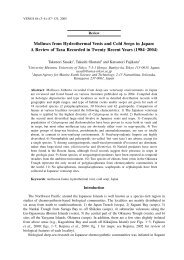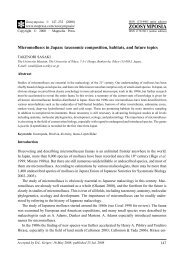Molluscan Research: Techniques for collecting, handling, preparing ...
Molluscan Research: Techniques for collecting, handling, preparing ...
Molluscan Research: Techniques for collecting, handling, preparing ...
You also want an ePaper? Increase the reach of your titles
YUMPU automatically turns print PDFs into web optimized ePapers that Google loves.
8<br />
after it has been immersed in corrosive chemicals. Needles,<br />
pins or razor blade fragments can be glued or otherwise<br />
attached to tooth picks or other wooden sticks. Heated<br />
needles can be pushed into thin wooden strips or perspex/<br />
plexiglass rods, but the heating makes the metal more<br />
sensitive to corrosion.<br />
Surgical needle holders are useful <strong>for</strong> holding small<br />
needles, pieces of a razor blade (or anything else thin or flat).<br />
There are also special ‘blade holders’ available <strong>for</strong> this<br />
purpose.<br />
Pins and needles<br />
Needles are probably the most important piece of<br />
equipment <strong>for</strong> radular and many other micromollusc<br />
applications. The finest and most expensive needles are<br />
made from electrolytically etched tungsten wire (USD/Euro<br />
5–10 each) with a 1 µm point (Fig. 4C). These can also be<br />
made using tungsten wire and suitable equipment (Hubel<br />
1957). Their points can easily be de<strong>for</strong>med, which is<br />
sometimes an advantage <strong>for</strong> certain types of manipulation.<br />
Micro-pins used to pin small insects come in black or<br />
stainless steel and in diameters from 0.1 to 0.2 mm. The<br />
stainless steel needles are less prone to rust and the thicker<br />
ones are stiffer but less pointed, with much variation in the<br />
shape and quality of the point. The black steel pins are<br />
sensitive to rust (Fig. 4B) although their life is prolonged by<br />
rinsing and drying after use. Household pins are much<br />
blunter and thicker but are often made of chromium plated<br />
brass and are less sensitive to chemicals. Sewing needles are<br />
made of chromium plated steel, available in many sizes and<br />
can be useful <strong>for</strong> work on larger specimens (Fig. 4A). Most<br />
of the ready-made needles <strong>for</strong> surgical use are inferior to<br />
micro-pins and much more expensive.<br />
All metal needles or pins can be bent by holding the<br />
very tip with a pair of watchmaker’s <strong>for</strong>ceps and bending the<br />
outermost fraction of a mm to a suitable angle. This tool is<br />
useful <strong>for</strong> moving radulae from one rinse to the next (see<br />
below). Such needles, including those with a minute hooklike<br />
end, are also valuable <strong>for</strong> dissecting. A needle with its<br />
point bent at 45° is excellent <strong>for</strong> picking small single valves<br />
of small bivalves; turn the shell so the concavity is up and<br />
‘hook’ the valve under the hinge. Needles with a 60° bent<br />
point are good <strong>for</strong> pulling the animal out of coiled shells. The<br />
needle point is inserted along the wall of the shell, then the<br />
point rotated to hook the animal.<br />
Hairs<br />
For cleaning dust particles from mounted radulae it is<br />
often better to use hairs (rather than a pin) glued to a small<br />
handle of wood or inserted into a holder. Eyebrow hairs (if<br />
straight) and eyelashes are commonly used but some animal<br />
hairs such as the pointed and stiff whiskers of a cat make<br />
very good tools. The stiffness of hairs decreases with<br />
increasing length of the hair.<br />
Brushes<br />
One centimetre wide brushes are useful <strong>for</strong><br />
manipulating dry samples while the finest brushes can be<br />
GEIGER ET AL. (2007) MOLLUSCAN RESEARCH, VOL. 27<br />
used <strong>for</strong> manipulating individual specimens. The diameters<br />
of brushes are graded, with ‘0000’ being the finest, and may<br />
be made of either synthetic fibre or natural hair. Synthetic<br />
fibre is chemically more resistant, can be used with bleach<br />
and hydroxides used in radular extraction and are usually a<br />
little stiffer. Natural hairs are often better <strong>for</strong> picking up<br />
small shells but are more expensive. It may be necessary to<br />
shape the tip, or to increase the stiffness of the brush by<br />
shortening the hairs. Many fine paintbrushes have one or a<br />
few much thicker and stiffer hairs to act as a support <strong>for</strong> the<br />
others. These can be cut off to avoid the risk of specimen<br />
damage if the brush is used <strong>for</strong> cleaning.<br />
Pliers<br />
The smallest sizes of regular tool pliers are useful <strong>for</strong><br />
cracking and opening small shells. Locking vice grip pliers<br />
will prevent the specimens being crushed. For most<br />
microshells, dissolving the shell is a better method (see<br />
below). Wire cutters <strong>for</strong> electronic use come with a variety of<br />
cutting edges, pointed, blunt, straight, angled, etc. and some<br />
are made of stainless steel. These are good <strong>for</strong> opening<br />
medium-sized (>5 mm) shells from the aperture, by breaking<br />
the outer lip. For cutting steel needles, use wire cutters with<br />
tungsten carbide edges. Watchmakers <strong>for</strong>ceps can be used <strong>for</strong><br />
cracking very small shells (see below <strong>for</strong> details).<br />
Drills<br />
Some power tools resembling a dentist’s drill have a<br />
flex-shaft attachment and a variety of rotary tool bits,<br />
engraving cutters and high-speed cutters that can be used to<br />
open shells with minimal damage. Drill bits are available<br />
down to about 0.7 mm diameter and can be used <strong>for</strong> grinding<br />
a hole of >0.7 mm diameter in the back of the shell. A hole<br />
can be made in thin-shelled species simply by scratching the<br />
shell with a needle.<br />
Tool sharpening<br />
A few different types of very small files <strong>for</strong> jewellery<br />
work are useful, both <strong>for</strong> keeping other tools in shape and <strong>for</strong><br />
filing holes in 3–5 mm (or larger) shells. Files rust easily so,<br />
if in contact with seawater, they need to be rinsed with hot<br />
fresh-water and wiped dry.<br />
For the rough shaping of coarser tools, a bench grinder<br />
with as fine a wheel as possible can be used. For more<br />
detailed work use fine sand- or carborundum paper or<br />
sharpening stones. For the final sharpening of <strong>for</strong>ceps and<br />
needles, use a fine-grained stone such as ‘Arkansas Stone’<br />
(see also http://www.antiquetools.com/sharp/sharphistory.<br />
html). With some practice, a good point can be achieved <strong>for</strong><br />
watchmakers and some other <strong>for</strong>ceps. Start with (if<br />
necessary) roughly bending the tips so they are parallel, then<br />
grind them off to the same length and start sharpening on a<br />
fine carborundum stone. The final grinding is done on an<br />
Arkansas stone, by moving it back and <strong>for</strong>th in the direction<br />
of the points. The finishing should be done under a<br />
stereomicroscope <strong>for</strong> better control.




